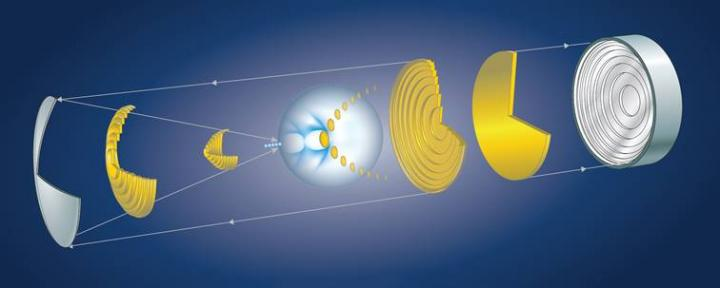Apr 6 2020
Researchers have now revealed clues about particles that constitute the universe by perceiving electrons that have been expedited to very high energies.
 Illustration depicting the method outline by LLE researchers to shape intense laser light in a way that accelerates electrons to record energies in very short distances. An ultrashort pulse (yellow) propagating to the right and reflecting from a radial echelon (rightmost element) controls the time at which each ring comes to focus after reflecting from an axiparabolla (left most element). Image Credit: H. Palmer and K. Palmisano.
Illustration depicting the method outline by LLE researchers to shape intense laser light in a way that accelerates electrons to record energies in very short distances. An ultrashort pulse (yellow) propagating to the right and reflecting from a radial echelon (rightmost element) controls the time at which each ring comes to focus after reflecting from an axiparabolla (left most element). Image Credit: H. Palmer and K. Palmisano.
However, it is very difficult to accelerate electrons to such extremely high energies in a laboratory environment; more energetic electrons usually translate to bigger particle accelerator. For example, researchers at the CERN laboratory based in Switzerland utilized almost a 17-miles long particle accelerator to identify the Higgs boson—the newly visualized “God particle” that accounts for the mass in the universe.
But it was speculated that there might be a way to downsize particle accelerators and generate high-energy electrons in just a fraction of the distance.
In a study published in the Physical Review Letters journal, researchers from the Laboratory for Laser Energetics (LLE) of the University of Rochester have described a technique to mold powerful laser light in a way that speeds up electrons to very high energies in extremely short distances: According to the team’s estimation, the particle accelerator would be 10,000 times smaller when compared to that of a recommended setup recording analogous energy, thus scaling down the particle accelerator from almost the length of Rhode Island to merely the length of a dining room table.
With a technology like that, researchers can potentially carry out tabletop experiments to explore the Higgs boson or to investigate the existence of additional dimensions and innovative particles that may result in Albert Einstein’s vision of a magnificent unified concept of the universe.
The higher energy electrons are required to study fundamental particle physics. Electron accelerators provide a looking glass into a sub-atomic world inhabited by the fundamental building blocks of the universe.
John Palastro, Study Lead Author and Scientist, Laboratory for Laser Energetics, University of Rochester
Even though this study is presently believed to be theoretical, the LLE is looking for ways to make it a reality through strategies to build the world’s extremely powerful laser at the LLE.
This laser would be called EP-OPAL and will enable the scientists to generate highly intense sculpted light pulses and technology that have been illustrated in the article.
The electron accelerator defined by the scientists depends on a ground-breaking method for carving the shape of laser pulses to allow their peaks to move more rapidly than that of the speed of light.
This technology could allow electrons to be accelerated beyond what is possible with current technologies.
Dustin Froula, Study Co-Author and Senior Scientist, Laboratory for Laser Energetics, University of Rochester
The scientists created an innovative optic setup to sculpt the laser pulses. This optic setup looks like a circular amphitheater with wavelength-sized “steps” employed to generate a time delay between concentric rings of light that was sent from a very powerful laser.
Through a standard lens, each concentric ring of light from a laser is focused on a single distance from the lens, which forms a solo spot of high-intensity light. But rather than using a standard lens, the scientists utilized an unusually shaped lens that enables them to direct each concentric ring of light to a different distance from the lens and thus produce a high-intensity line instead of a single spot.
Upon entering a plasma, which is a hot soup of freely traveling ions and electrons, the sculpted light pulse generates a wake, which is analogous to the wake behind a motorboat. This wake travels at the speed of light. Just like how a water skier rides in a boat’s wake, the electrons subsequently speed up while riding the wake of the sculpted laser light pulses.
These “laser wakefield accelerators” (or LWFA for short) were originally conceptualized almost four decades ago, and since then they have been improvised by the development of chirped-pulse amplification (CPA)—a method devised at the LLE by Donna Strickland and Gerard Mourou, who both received the 2018 Nobel Prize.
But earlier LWFA versions utilized the conventional, unstructured pulses of light that traveled more gradually than that of the light’s speed, implying that the electrons would outpace the wake and restrict their acceleration.
The novel sculpted light pulses allow speeds that are faster than that of light and, therefore, electrons can ride the wake for an indefinite period of time and be repeatedly expedited.
This work is extremely innovative and would be a game changer for laser-accelerators. This research shows the value of theoretical and experimental plasma physics working closely together with outstanding laser scientists and engineers—it represents the best of the culture of LLE.
Michael Campbell, Director, Laboratory for Laser Energetics, University of Rochester
The study was financially supported by the New York State Energy Research and Development Authority and the U.S. Department of Energy (DOE) Office of Fusion Energy Sciences.